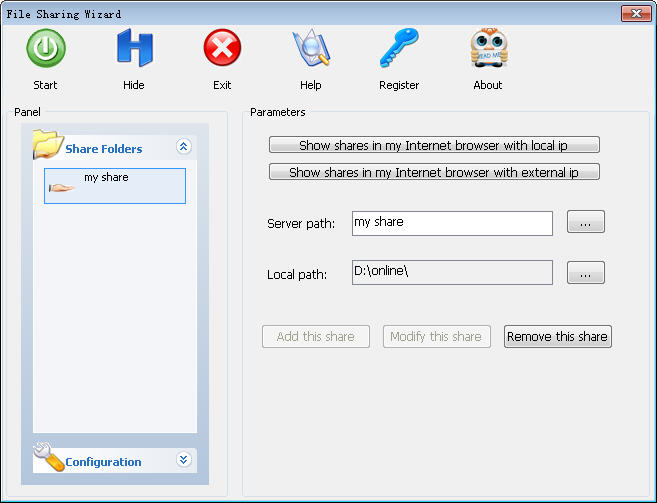

- #Reverse port forwarding wizard how to#
- #Reverse port forwarding wizard software#
Click Advanced in order to select the source and destination interfaces.
Click OK in order to add the NAT rule. Choose the configured NAT rule and change the Translated Addr to be the newly configured group 'nat-pat-group' (was previously 'obj-my-range'). In the Group Name field, enter a group name and add both address objects (NAT range and PAT IP address) in the group. Click Add to add a network object group. In the IP Address field, enter the PAT backup IP address. Repeat steps 1 to 3 in the previous configuration and click Add once again in order to add a network object. As a result, you could try to implement dynamic NAT with dynamic PAT backup or you could try to expand the current pool. If the mapped pool has fewer addresses than the real group, you could run out of addresses. This is the equivalent CLI output for this ASDM configuration: object network obj-my-rangeĪs per this configuration, the hosts in the 172.16.11.0 network get translated to any IP address from the NAT pool, 203.0.113.10 - 203.0.113.20. In the Translated Addr field, choose the address object. In the Start Address and End Address fields, enter the starting and ending PAT IP addresses. In the Type drop-down list, choose Range. 
In the Translated Addr field, choose the appropriate selection. In the Type drop-down list, choose Dynamic. Check the Add Automatic Address Translation Rules check box. In this example, the entire inside-network has been selected. Configure the network/Host/Range for which Dynamic PAT is required.In order to accomplish this, you need to select the real address of the hosts/networks to be given access and they then have to be mapped to a pool of translated IP addresses.Ĭomplete these steps in order to allow inside hosts access to outside networks with NAT: As a result, a host is mapped to its own translated IP address and two hosts cannot share the same translated IP address. Unlike PAT, Dynamic NAT allocates translated addresses from a pool of addresses. You could allow a group of inside hosts/networks to access the outside world with the configuration of the dynamic NAT rules. This is the equivalent CLI output for this PAT configuration: object network obj_172.16.11.0Īllow Inside Hosts Access to Outside Networks with NAT Click OK and click Apply for the changes to take effect. In the Source Interface and Destination Interface drop-down lists, choose the appropriate interfaces.In the Translated Addr field, choose the option to reflect the outside interface. In the Type drop-down list, choose Dynamic PAT (Hide). This process can be repeated for other subnets you wish to translate in this manner. In this example, one of the inside subnets has been selected.

Click Add and then choose Network Object in order to configure a dynamic NAT rule.
 Choose Configuration > Firewall > NAT Rules. This is the typical PAT configuration that is used when the number of routable IP addresses available from the ISP is limited to only a few, or perhaps just one.Ĭomplete these steps in order to allow inside hosts access to outside networks with PAT: One of the simplest PAT configurations involves the translation of all internal hosts to look like the outside interface IP address. If you want inside hosts to share a single public address for translation, use Port Address Translation (PAT). Allow Inside Hosts Access to Outside Networks with PAT They are RFC 1918 addresses which have been used in a lab environment. The IP address schemes used in this configuration are not legally routable on the Internet. If your network is live, ensure that you understand the potential impact of any command." Configure Network Diagram All of the devices used in this document started with a cleared (default) configuration. "The information in this document was created from the devices in a specific lab environment.
Choose Configuration > Firewall > NAT Rules. This is the typical PAT configuration that is used when the number of routable IP addresses available from the ISP is limited to only a few, or perhaps just one.Ĭomplete these steps in order to allow inside hosts access to outside networks with PAT: One of the simplest PAT configurations involves the translation of all internal hosts to look like the outside interface IP address. If you want inside hosts to share a single public address for translation, use Port Address Translation (PAT). Allow Inside Hosts Access to Outside Networks with PAT They are RFC 1918 addresses which have been used in a lab environment. The IP address schemes used in this configuration are not legally routable on the Internet. If your network is live, ensure that you understand the potential impact of any command." Configure Network Diagram All of the devices used in this document started with a cleared (default) configuration. "The information in this document was created from the devices in a specific lab environment. #Reverse port forwarding wizard software#
Cisco ASA 5525 Series Security Appliance Software Version 9.x and later. The information in this document is based on these software and hardware versions: Refer to Configuring Management Access in order to allow the device to be configured by the ASDM. Refer to the Cisco ASA Series Firewall ASDM Configuration Guide for additional information. #Reverse port forwarding wizard how to#
This document describes how to configure Port Redirection (Forwarding) and the outside Network Address Translation (NAT) features in Adaptive Security Appliance (ASA) Software Version 9.x, with the use of the CLI or the Adaptive Security Device Manager (ASDM).








 0 kommentar(er)
0 kommentar(er)
